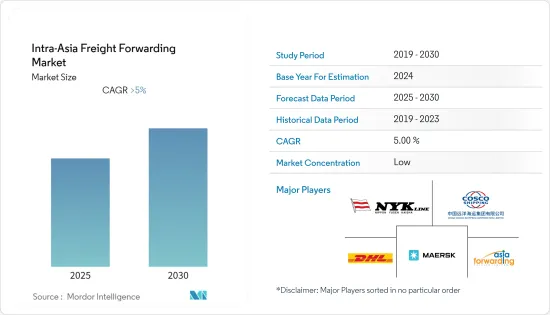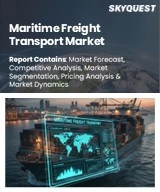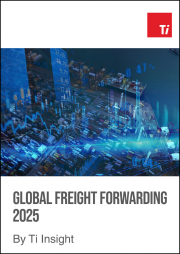
|
시장보고서
상품코드
1683803
아시아 역내 화물 포워딩 : 시장 점유율 분석, 산업 동향, 성장 예측(2025-2030년)Intra-Asia Freight Forwarding - Market Share Analysis, Industry Trends & Statistics, Growth Forecasts (2025 - 2030) |
||||||
아시아 역내 화물 포워딩 시장은 예측 기간 동안 CAGR 5% 이상으로 성장할 전망입니다.

주요 하이라이트
- 코로나19 팬데믹으로 인해 전 세계가 봉쇄되고 상업 활동이 중단되면서 경제가 어려워지고 운영, 공급망, 규제, 인력 요구사항이 크게 변화하면서 화물 포워딩 시장이 혼란에 빠졌습니다. 2020년 항공 및 해상 화물 물동량은 크게 감소했으며, 2020년 첫 몇 달 동안 중국 항구에서 처리된 총 해상 화물 컨테이너 물동량은 10.1% 감소했습니다. 이후 제한이 완화되면서 지역 전체에서 화물 이동이 크게 증가했습니다.
- 각국은 국경 간 무역을 활성화하기 위한 공동 프로젝트를 진행하고 있습니다. 예를 들어, 2023년 1월 인도 도로교통부와 일본 대표단은 지능형 교통 시스템과 친환경 모빌리티 분야의 디지털 전환을 위한 프로젝트를 진행하기 위해 만났으며, 인도와 일본 간 도로를 건설하여 사람과 물품이 더 쉽게 이동할 수 있도록 할 계획도 세웠습니다
- 한편, 항공 회사인 스위스포트는 증가하는 화물 포워딩 수요를 충족하기 위해 2022년 10월 중부 일본 국제 공항에 새로운 항공 화물 센터를 개장했습니다.
- 한편, 아시아는 현재 세계의 물류 허브로 부상하고 있으며, 2030년까지 전 세계 무역 성장의 절반 가량을 담당할 것으로 예상됩니다. 또한 더 많은 스타트업, 인수합병으로 2021년 1분기에 250억 달러 이상의 자금이 아시아로 유입되었습니다. 따라서 이 지역의 화물 포워딩업체는 늘어나는 프로젝트와 무역 활동으로 인해 많은 비즈니스를 기대할 수 있습니다.
아시아 역내 화물 포워딩 시장 동향
급성장하는 전자상거래 부문이 시장을 주도
2022년 아시아 태평양 지역의 전자상거래는 급속한 도시화, 중산층 증가, 디지털 결제 보급률 증가, 전자상거래 생태계의 확장에 힘입어 크게 성장했습니다. 또한 팬데믹의 확산은 이 지역의 온라인 소매 판매를 가속화하는 촉매제 역할을 했습니다. 전자상거래 생태계가 성장하려면 화물의 원활한 이동을 위한 화물 및 물류 지원이 필요합니다.
게다가 전자상거래의 성장은 소매업계를 옴니채널로 이끌고 있으며, 2021년 이 지역은 디지털 매출이 2조 9,000억 달러에 달하는 최대 소매 전자상거래 시장으로, 북미보다 3배, 서유럽보다 5배 가까이 큰 매출을 기록했습니다. 또한 2022년에는 중국이 전자상거래 시장을 큰 폭으로 앞지를 것으로 예상됩니다.
한편, 2022년에는 FMCG(Fast-Moving Consumer Goods)의 전자상거래는 전통적인 무역에 이어 두 번째로 큰 소매 채널로 부상하여 이 지역 전체 매출의 19% 이상을 차지할 것으로 예상됩니다. 그러나 업계 전문가의 추정에 따르면, 한국(34%)과 중국(31%)에서는 전자상거래가 FMCG 매출의 30% 가까이를 차지하고 있습니다. 게다가 2022년에는 중국이 이 지역 온라인 지출액 1위를 차지했고, 인도네시아와 인도가 그 뒤를 이었습니다. 이처럼 전자상거래 매출 증가는 상품의 원활한 종단 간 이동을 위한 체계적인 공급망과 물류 서비스를 강화하여 화물 포워딩 시장의 확대로 이어지고 있습니다.
시장에서 현저한 성장을 나타내는 일본
일본의 화물 포워딩 비즈니스는 빠르게 성장하고 있습니다. 이는 주로 수출입과 같은 무역 활동이 증가했기 때문이며, 2022년 12월 일본의 수출은 전년 동기 대비 17% 이상의 성장률을 기록했고 수입은 41%에 육박했습니다. 또한, 2021년 일본의 총 상품 수출액은 7,500억 달러 이상으로 전년 대비 18% 증가했습니다.
또한 2021년 일본의 주요 수출처는 수출 점유율이 21% 가까운 중국(1,600억 달러), 수출 점유율이 6.9% 가까운 한국(520억 달러), 수출 점유율이 각각 4.6%와 4.3%인 홍콩과 태국입니다. 또한 중국은 가장 큰 수입국 중 하나이며 그 점유율은 24%(1조 8,750억 달러)를 초과합니다. 호주 및 기타 아시아 국가도 큰 수입국입니다.
또한 항공 화물 운송도 크게 성장하고 있습니다. 이는 무역이 증가하고, 트럭 운전사가 부족하고, 항만 교통이 악화되고 있기 때문입니다. 2021년 일본 최대 항공화물 공항인 나리타 공항은 전년 대비 32% 증가한 260만 톤 이상의 항공화물을 처리할 것으로 예상됩니다. 또한 2021년 일본 공항의 항공화물 처리량은 499만 톤 이상으로 전년 대비 18% 증가했습니다. 따라서 일본 내 화물 포워더에 대한 수요는 화물 운송의 성장에 의해 주도될 것으로 보입니다.
아시아 역내 화물 포워딩 산업 개요
아시아 역내 화물 포워딩 시장은 세계 및 지역 기업이 혼재하는 단편 시장입니다. 현지 중소기업은 소규모 함대와 보관 공간에서 시장에 서비스를 제공합니다. 화물 포워딩 시장은 꾸준히 성장하고 있으며 비즈니스 기회도 풍부하기 때문에 각 기업은 기술을 통합하고 디지털화를 진행하며 비즈니스 규모와 효율성을 높여야 합니다. 세계에 퍼져있는 강력한 네트워크를 갖는 것은 기업에게 중요합니다. 또한 시장의 주요 기업으로는 Asia Forwarding Private Limited, DHL, UPS, 일본 우선 등이 있습니다.
기타 혜택
- 엑셀 형식 시장 예측(ME) 시트
- 3개월간의 애널리스트 서포트
목차
제1장 서론
- 조사의 성과
- 조사의 전제
- 조사 범위
제2장 조사 방법
- 분석 방법
- 조사 단계
제3장 주요 요약
제4장 시장 인사이트
- 현재의 시장 시나리오
- 밸류 체인 및 공급망 분석
- 투자 시나리오에 대한 통찰
- 정부의 규제와 대처에 관한 통찰
- 온라인 화물 포워딩 및 디지털 플랫폼의 기술 개발 개요
- 화물 포워딩 시장의 디지털화
- 전자상거래 물류 및 화물 포워딩의 개요
- 시장에 대한 COVID-19의 영향
제5장 시장 역학
- 성장 촉진요인
- 억제요인
- 기회
- 업계의 매력도 - Porter's Five Forces 분석
- 공급기업의 협상력
- 소비자의 협상력
- 신규 참가업체의 위협
- 대체품의 위협
- 경쟁 기업간 경쟁 관계
제6장 시장 세분화
- 수송 형태별
- 해상화물 포워딩
- 항공화물 포워딩
- 도로화물 포워딩
- 철도화물 포워딩
- 고객 유형별
- 기업간 수송(B2B)
- 기업 대 고객(B2C)
- 용도별
- 산업 및 제조
- 소매
- 의료
- 석유 및 가스
- 식음료
- 기타 용도
- 지역별
- 중국
- 일본
- 한국
- 인도
- 기타 아시아
제7장 경쟁 구도
- 시장 집중도 개요
- 기업 프로파일
- Maersk
- DB Schenker
- DHL
- FedEx
- CHINA COSCO SHIPPING
- NYK Line
- Yamato Transport Co., Ltd.
- Hitachi Transport System, Ltd.
- CEVA Logistics
- Kuehne Nagel
- Asia Forwarding Private Limited.
- XPO, Inc.
- UPS*
제8장 화물 포워딩 시장의 미래
제9장 부록
HBR 25.04.11The Intra-Asia Freight Forwarding Market is expected to register a CAGR of greater than 5% during the forecast period.

Key Highlights
- The COVID-19 pandemic led to global lockdowns, and commercial activities were halted, challenging the economy and disrupting the freight forwarding market with massive changes in operations, supply chains, regulations, and workforce requirements. Air and ocean freight volumes fell significantly in 2020; total ocean freight container volumes handled at Chinese ports dropped by 10.1% in the first few months of 2020. Later, as restrictions eased, cargo movement increased significantly across the region.
- Countries are also working on joint projects to boost cross-border trade. For example, in January 2023, the Indian Ministry of Road Transportation and Highways and the Japanese Delegation met to work on projects for digital transformation in the areas of intelligent transportation systems and eco-friendly mobility.The committee also planned to build roads between India and Japan so that people and goods could move more easily.
- In the meantime, Swissport, an aviation company, opened a new air cargo center at Central Japan International Airport in October 2022 to meet the growing demand for freight transport.
- Asia, on the other hand, is becoming a global logistics hub right now, and it is expected that the region will be responsible for about half of the world's trade growth by 2030. Also, more start-ups, mergers, and acquisitions brought more than USD 25 billion to Asia in the first quarter of 2021. So, the region's freight forwarders can expect a lot of business from the growing number of projects and trade activities.
Intra-Asia Freight Forwarding Market Trends
Booming E-commerce Sector is Driving the Market
In 2022, e-commerce in the Asia Pacific region witnessed significant growth, primarily driven by rapid urbanization, the growing middle class, the increasing penetration of digital payments, and the expansion of the e-commerce ecosystem. In addition, the pandemic outbreak also acted as a catalyst for accelerating online retail sales in the region. The growing e-commerce ecosystem requires freight and logistics support for the smooth movement of shipments.
Moreover, e-commerce growth is driving the retail industry toward omnichannel, and in 2021, the region remained the largest market for retail e-commerce, with digital sales amounting to more than USD 2.9 trillion, whereas these sales were three times greater than those in North America and nearly five times greater than those in Western Europe. In addition, in 2022, China will have outperformed the e-commerce market by a large margin.
Meanwhile, in 2022, fast-moving consumer goods (FMCG) e-commerce emerged as the second-biggest retail channel next to traditional trade, which accounted for more than 19% of sales in the region. However, as per industry experts' estimates, e-commerce accounts for nearly 30% of FMCG sales in South Korea (34%), and China (31%). Moreover, in 2022, China topped online spending in the region, followed by Indonesia and India. Thus, the growing e-commerce sales boost the systematic supply chain and logistics services to provide smooth end-to-end transfers of goods, further resulting in the expansion of the freight forwarding market.
Japan is Experiencing Significant Growth in the Market
Japan's freight forwarding business is growing quickly. This is mostly due to more trade activities like importing and exporting.In December 2022, exports from the country reached a growth rate of more than 17%, and imports reached nearly 41% when compared to the same period in the previous year. Also, Japan's total exports of goods were worth more than USD 750 billion in 2021, which was an increase of 18% from the year before.
Moreover, in 2021, the major export destinations of Japan will be China with an export share of nearly 21% (USD 160 billion), Korea with an export share of nearly 6.9% (USD 52 billion), and Hong Kong and Thailand with an export share of 4.6% and 4.3%, respectively. Also, China is one of the biggest importers, with a share of more than 24% (1875 billion USD). Australia and other Asian countries are also big importers.
Also, air cargo transportation is growing a lot in the country. This is mostly because trade is growing, there aren't enough truck drivers, port traffic is getting worse, etc. In 2021, Japan's Narita Airport, the country's largest airport for air freight, will handle more than 2.6 million tons of air cargo, an increase of 32% when compared to the previous year. In addition, in 2021, the volume of air freight handled at Japanese airports amounted to more than 4.99 million tons, which was up by 18% when compared to the previous year. So, the demand for freight forwarders in the country is likely to be driven by the growth of freight forwarding.
Intra-Asia Freight Forwarding Industry Overview
The intra-Asia freight forwarding market's landscape is fragmented by nature, with a mix of global, regional, and local players. Small- and medium-sized local players still serve the market with small fleets and storage spaces. As the freight forwarding market is growing steadily and there is abundant opportunity, the players need to embrace technologies, become more digitized, and increase the scale and efficiency of their operations. Having a strong network spanning the globe is important for companies. In addition, some of the major players in the market include Asia Forwarding Private Limited, DHL, UPS, NYK Line, etc.
Additional Benefits:
- The market estimate (ME) sheet in Excel format
- 3 months of analyst support
TABLE OF CONTENTS
1 INTRODUCTION
- 1.1 Study Deliverables
- 1.2 Study Assumptions
- 1.3 Scope of the Study
2 RESEARCH METHODOLOGY
- 2.1 Analysis Methodology
- 2.2 Research Phases
3 EXECUTIVE SUMMARY
4 MARKET INSIGHTS
- 4.1 Current Market Scenario
- 4.2 Value Chain / Supply Chain Analysis
- 4.3 Insights on Investment Scenarios
- 4.4 Insights on Government Regulations and Initiatives
- 4.5 Brief on Technology Development in Online Freight Forwarding and Digital Platforms
- 4.6 Digitalisation of Freight Forwarding Market
- 4.7 Overview on E-commerce Logistics and Freight Forwarding
- 4.8 Impact of COVID-19 on the Market
5 MARKET DYNAMICS
- 5.1 Drivers
- 5.2 Restraints
- 5.3 Opportunities
- 5.4 Industry Attractiveness - Porter's Five Forces Analysis
- 5.4.1 Bargaining Power of Suppliers
- 5.4.2 Bargaining Power of Consumers
- 5.4.3 Threat of New Entrants
- 5.4.4 Threat of Substitutes
- 5.4.5 Intensity of Competitive Rivalry
6 MARKET SEGMENTATION
- 6.1 By Mode of Transportation
- 6.1.1 Ocean Freight Forwarding
- 6.1.2 Air Freight Forwarding
- 6.1.3 Road Freight Forwarding
- 6.1.4 Rail Freight Forwarding
- 6.2 By Customer Type
- 6.2.1 Business to Business (B2B)
- 6.2.2 Business to Customer (B2C)
- 6.3 By Application
- 6.3.1 Industrial and Manufacturing
- 6.3.2 Retail
- 6.3.3 Healthcare
- 6.3.4 Oil And Gas
- 6.3.5 Food And Beverages
- 6.3.6 Other Applications
- 6.4 By Geography
- 6.4.1 China
- 6.4.2 Japan
- 6.4.3 South Korea
- 6.4.4 India
- 6.4.5 Rest of Asia
7 COMPETITIVE LANDSCAPE
- 7.1 Market Concentration Overview
- 7.2 Company Profiles
- 7.2.1 Maersk
- 7.2.2 DB Schenker
- 7.2.3 DHL
- 7.2.4 FedEx
- 7.2.5 CHINA COSCO SHIPPING
- 7.2.6 NYK Line
- 7.2.7 Yamato Transport Co., Ltd.
- 7.2.8 Hitachi Transport System, Ltd.
- 7.2.9 CEVA Logistics
- 7.2.10 Kuehne+Nagel
- 7.2.11 Asia Forwarding Private Limited.
- 7.2.12 XPO, Inc.
- 7.2.13 UPS*



















